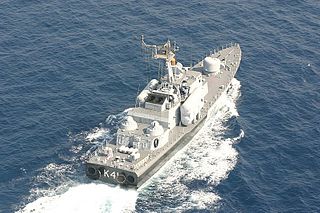
A corvette is a small warship. It is traditionally the smallest class of vessel considered to be a proper warship. The warship class above the corvette is that of the frigate, while the class below was historically that of the sloop-of-war. The modern types of ships below a corvette are coastal patrol craft, missile boat and fast attack craft. In modern terms, a corvette is typically between 500 tons and 2,000 tons, although recent designs may approach 3,000 tons, which might instead be considered a small frigate.

The Centaur class of aircraft carriers of the Royal Navy was the last of the light fleet carrier designs started during the closing years of World War II. The first ship of the original four in the class was commissioned in 1953 and the final decommissioned in 1984. The first three ships lacked an angled flight deck and were therefore unsuitable for fast jet aircraft, and production of a second batch of four carriers was cancelled.

Landing platform helicopter (LPH) is a term used by some navies to denote a type of amphibious warfare ship designed primarily to operate as a launch and recovery platform for helicopters and other VTOL aircraft. As such, they are considered a type of helicopter carrier.

The Independence-class aircraft carriers were a class of light carriers built for the United States Navy that served during World War II.

USS Ingersoll (DD-990), a Spruance-class destroyer, was the second U.S. Navy ship to be named USS Ingersoll; in this case, in honor of Admiral Royal E. Ingersoll (1883–1976), who served as CINC, Atlantic Fleet during most of World War II.

A helicopter carrier is a type of aircraft carrier whose primary purpose is to operate helicopters. A helicopter carrier has a large flight deck that occupies a large part of the ship, which can extend the full length of the ship like HMS Ocean of the Royal Navy (RN), or only partway, usually aft, as in the Soviet Navy's Moskva class or in the Chinese Navy's Type 0891A. It often also has a hangar deck for the storage of aircraft.

Aircraft carriers have their origins during the days of World War I. The earliest experiments consisted of fitting temporary "flying off" platforms to the gun turrets of the warships of several nations, notably the United States and the United Kingdom. The first ship to be modified with a permanent flight deck was the battlecruiser HMS Furious, which initially had a single flying-off deck forward of the original superstructure. Subsequently, she was modified with a separate "landing on" deck aft and later with a full flush deck. Other ships, often liners, were modified to have full flush flight decks, HMS Argus being the first to have such modification begun. Those first faltering steps gave little indication of just how important the aircraft carrier was to prove to be. During the inter-war years, Japan, the United Kingdom and the United States built up significant carrier fleets so that by the beginning of World War II, they had 18 carriers between them. The 1940 Battle of Taranto and 1941 Attack on Pearl Harbor in retrospect showed the world that the aircraft carrier was to be the most important ship in the modern fleet. Today, aircraft carriers are the capital ships of the navies they serve in, and in the case of modern US "supercarriers", they embark an air group that is effectively a small air force.

The Veer-class corvettes of the Indian Navy are a customised Indian variant of the Soviet Tarantul class. They form the 22nd Killer Missile Vessel Squadron.
HMS Sarawak (K591) was a Colony-class frigate of the United Kingdom that served during World War II. She originally was ordered by the United States Navy as the Tacoma-class patrol frigateUSS Patton (PF-87) and was transferred to the Royal Navy prior to completion.

USS LST-924 was an LST-542-class tank landing ship in the United States Navy. Like many of her class, she was not named and is properly referred to by her hull designation.
This page is based on this
Wikipedia article Text is available under the
CC BY-SA 4.0 license; additional terms may apply.
Images, videos and audio are available under their respective licenses.








